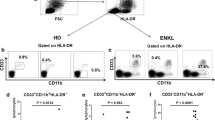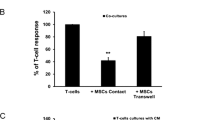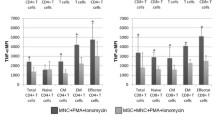Abstract
The increase of CD4+CD25+ regulatory T cells in patients with ovarian carcinoma has been verified. Here we investigated the effects of supernatant derived from ovarian carcinoma cell SKOV3 on peripheral regulatory T cells. Supernatant from SKOV3 was collected and fractionated into three different molecular weight fractions (MWFs). The proliferation of the CD4+CD25+ regulatory T cells cultured in complete RPMI 1640 medium with the different stimulators was detected. The phenotype (GITR and CTLA-4) of natural and expanded CD4+CD25+ T cells was detected by flow cytometry. Foxp3 mRNA expression of low MWF-expanded CD4+CD25+ T cells was detected by RT-PCR. Those expanded CD4+CD25+ regulatory T cells showed enhanced capacity to suppress CD4+CD25− T proliferation and increased expression of GITR and CTLA-4. In brief, low molecular weight fraction of supernatant secreted by SKOV3 could expand peripheral CD4+CD25+ regulatory T cells and enhance their suppressive function.



Similar content being viewed by others
References
Itoh M, Takahashi T, Sakaguchi N, Kuniyasu Y, Shimizu J, Otsuka F, et al. Thymus and autoimmunity: production of CD25+CD4+ naturally anergic and suppressive T cells as a key function of the thymus in maintaining immunologic self-tolerance. J Immunol. 1999;162(9):5317–26.
Apostolou I, Sarukhan A, Klein L, von Boehmer H. Origin of regulatory T cells with known specificity for antigen. Nat Immunol. 2002;3(8):756–63.
Zhang X, Izikson L, Liu L, Weiner HL. Activation of CD25+ CD4+ regulatory T cells by oral antigen administration. J Immunol. 2001;167(8):4245–53.
Thornton AM, Shevach EM. CD4+CD25+ immunoregulatory T cells suppress polyclonal T cell activation in vitro by inhibiting interleukin 2 production. J Exp Med. 1998;188(2):287–96.
Dieckmann D, Plottner H, Berchtold S, Berger T, Schuler G. Ex Vivo isolation and characterization of CD4+CD25+ T cells with regulatory properties from human blood. J Exp Med. 2001;193(11):1303–10.
Thornton AM, Shevach EM. Suppressor effector function of CD4+CD25+ immunoregulatory T cells is antigen nonspecific. J Immunol. 2000;164(1):183–90.
Curiel TJ, Couko G, Zou L. Specific recruitment of regulatory T cells in ovarian carcinoma fosters immune privilege and predicts reduced survival. Nat Med. 2004;10(9):942–9.
Steitz J, Bruck J, Lenz J, Knop J, Tuting T. Depletion of CD25+CD4+ T cells and treatment with tyrosinase-related protein 2-transduced dendritic cells enhance the interferon α-induced CD8+ T cell dependent immune defense of B 16 melanoma. Cancer Res. 2001;61(24):8643–6.
Seo N, Hayakawa S, Takigawa M, Tokura Y. Interleukin-10 expressed at early tumor sites induces subsequent generation of CD4+ T-regulatory cells and systemic collapse of antitumour immunity. Immunology. 2001;103(4):449–57.
Woo EY, Chu CS, Goletz TJ, Schlienger K, Yeh H, Coukos G, et al. Regulatory CD4+CD25+ T cells in tumors from patients with early-stage non-small cell lung cancer and late-stage ovarian cancer. Cancer Res. 2001;61(12):4766–72.
Wolf AM, Wolf D, Steurer M, Gastl G, Gunsilius E, Grubeck-Loebenstein B. Increase of regulatory T cells in the peripheral blood of cancer patients. Clin Cancer Res. 2003;9(2):606–12.
Li Xiao, Ye Dafeng, Xie Xing, Chen Huaizeng, Lu Weiguo. Increase of CD4+CD25+ regulatory T cell in the patients with ovarian carcinoma. Cancer Invest. 2005;23(5):399–403.
Walker MR, Kasprowicz DJ, Gersuk VH, et al. Induction of FoxP3 and acquisition of T regulatory activity by stimulated human CD4+CD25− T cells. J Clin Invest. 2003;112(9):1437–43.
Li Xiao, Ye Feng, Chen Huaizeng, Lu Weiguo, Wan Xiaoyun, Xie Xing. Human ovarian carcinoma cells generate CD4+CD25+ regulatory T cells from peripheral CD4+CD25− T cells through secreting TGF-β. Cancer Lett. 2007;253(1):144–53.
Jonuleit H, Schmitt E, Stassen M, Tuettenberg A, Knop J, Enk AH. Identification and functional characterization of human CD4+CD25+ T cells with regulatory properties isolated from peripheral blood. J Exp Med. 2001;193(11):1285–94.
Shimizu J, Yamazaki S, Takahashi T, Ishida Y, Sakaguchi S. Stimulation of CD25+CD4+ regulatory T cells through GITR breaks immunological self-tolerance. Nat Immunol. 2002;3(2):135–42.
Levings MK, Sangregorio R, Sartirana C, Moschin AL, Battaglia M, Orban PC, et al. Human CD25+CD4+ T suppressor cell clones produce transforming growth factor beta, but not interleukin 10, and are distinct from type 1 T regulatory cells. J Exp Med. 2002;196(10):1335–46.
Birebent B, Lorho R, Lechartier H, de Guibert S, Alizadeh M, Vu N, et al. Suppressive properties of human CD4+CD25+ regulatory T cells are dependent on CTLA-4 expression. Eur J Immunol. 2004;34(12):3485–96.
Dujardin HC, Burlen-Defranoux O, Boucontet L, Vieira P, Cumano A, Bandeira A. Regulatory potential and control of Foxp3 expression in newborn CD4+ T cells. Proc Natl Acad Sci USA. 2004;101(40):14473–8.
Khattri R, Cox T, Yasayko SA, Ramsdell F. An essential role for scurfin in CD4+CD25+ T regulatory cells. Nat Immunol. 2003;4(4):337–42.
Fontenot JD, Gavin MA, Rudensky AY. Foxp3 programs the development and function of CD4+CD25+ regulatory T cells. Nat Immunol. 2003;4(4):330–6.
Hori S, Nomura T, Sakaguchi S. Control of regulatory T cell development by the transcription factor Foxp3. Science. 2003;299(5609):1057–61.
Li B, Saouaf SJ, Samanta A, Shen Y, Hancock WW, Greene MI. Biochemistry and therapeutic implications of mechanisms involved in FOXP3 activity in immune suppression. Curr Opin Immunol. 2007;19(5):583–8.
Acknowledgments
Financial support for this work was provided by the project of Natural Scientific Foundation of Zhejiang Province (Grant code: Y207054) and the project of Zhejiang education office (20070245).
Author information
Authors and Affiliations
Corresponding author
Rights and permissions
About this article
Cite this article
Li, X., Wan, X., Mao, Y. et al. Low molecular weight fraction secreted by SKOV3 cells expands peripheral CD4+CD25+ regulatory T cells and enhances their suppressive capacity. Med Oncol 27, 600–606 (2010). https://doi.org/10.1007/s12032-009-9255-3
Received:
Accepted:
Published:
Issue Date:
DOI: https://doi.org/10.1007/s12032-009-9255-3




